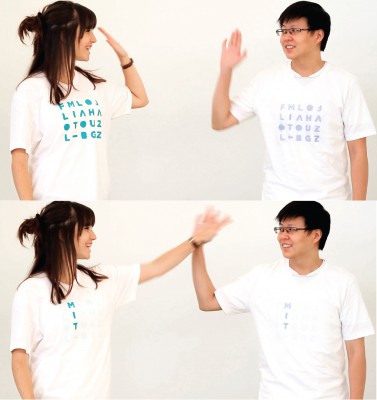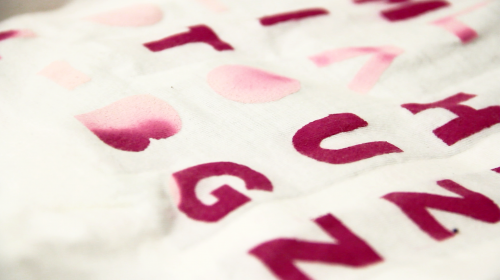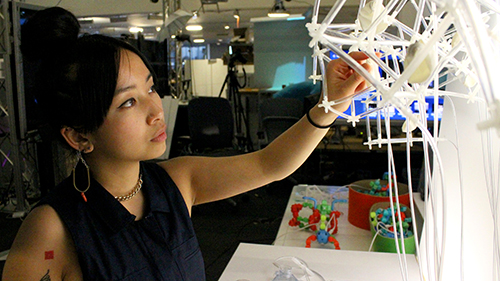“I think there’s a lot of space for designers to expand beyond the producer/client model and become knowledge makers, cultural disruptors and gatekeepers between pure economic gain and the well-being of humanity,” said alumna Viirj Kan (BS ’14 Environmental), currently a graduate student and researcher at MIT Media Lab.
Born in Macau, China and raised in Las Vegas, Nevada, Kan’s work is inspired by the laws of nature, science, social climates and shifts in the social norm.
Kan and her fellow MIT researchers developed TRANSFORM as Adaptive and Dynamic Furniture, an exploration of how shape display technology can be integrated into our daily lives as interactive, shape changing furniture. The project was recently honored with the Golden Mouse award at a gathering of experts in Seoul examining innovation around how humans interact with digital technologies.

Alum Viirj Kan’s research; Social Textiles: Social Affordances and Icebreaking Interactions Through Wearable Social Messaging (©2014 Tangible Media Group / MIT Media Lab)
Her tangible interface research project, Social Textiles, about wearable social messaging was featured in Fast Company, CNN, Designboom, Vice Creators Project, Inhabitat, Wareable, Ecouterre and other media outlets.
We caught up with Kan upon her return from the conference in Korea.
DL: What made you choose to attend Art Center?
VK: I wanted to find a gateway to engage in both science and art. Although underutilized by most students, I knew Art Center had a relationship with Caltech that enabled me to take classes there throughout my undergrad.
DL: What lessons did you learn at Art Center that have most benefited you as an artist?
VK: Art Center taught me how to make convincing presentations, instilled in me that details make a difference and that understanding who the audience is and users are is key.
DL: What was the biggest creative challenge/breakthrough you faced while at Art Center?
VK: Not fitting snuggly into a single department’s ethos as I decided to not fit myself within a streamlined curriculum. It eventually led me to uncovering my own motivations for why I make—which was not to get a job, work for a big company, make things for the sake of it, but to hone my professional, creative and intellectual developments towards uncovering new knowledge through design.
DL: Describe your most gratifying collaboration with a faculty member or student.
VK: Kendra Stanifer was my gateway into Art Center, then Catherine MacLean from Materials and Methods class and Jacki Apple’s Intro to Modernism kept me on board. James Meraz’s Environmental Design 1 made me pivot. Then, Robert Ball’s Environmental Design 4 transpired my pebbles into gold. Ali Modarres awakened my spirit in History and Theory of Space. Karen Hofmann’s INSEAD business program liberated me from my anxieties. Jeremy Ma and Michael Wolf’s Intro to Robotics solidified a curiosity into a love. Joe Reiter’s Theory of Structure and Visual Math nurtured the love into the next steps.
DL: Do you have any advice for students who are thinking about attending Art Center?
VK: Art Center is a great place for professional and skill-based development. It is also a gateway into producing high quality design. However, it embodies a particular value system. Don’t let it swallow you up. Stay in touch with faculty that you connect with. Take advantage of Art Center, the resources and make the curriculum yours.

MIT researcher Viirj Kan explores icebreaking interactions through wearables. (©2014 Tangible Media Group / MIT Media Lab)
DL: How would you describe your creative practice as it exists today?
VK: Working at the fringe of science fiction and reality, I do R&D to envision, prototype and develop future technologies that bridge the physical and digital world. My research involves developing a common language between humans and “machines”—whether it be gestural, spoken, haptic, textual or chemical. I am interested in how human behavior adapts and interacts with responsive systems whether they be environments, objects, materials or organisms. My responsibility as a researcher is to understand the nature of these interactions and to develop computational systems to enable people to interact with information in a more tangible way. I feel very grateful to be in an environment surrounded by scientists and engineers across different disciplines from physics to computer science and microbiology. Every day I am learning and growing along different directions that support my work.
DL: What have you been doing personally since you left Art Center?
VK: I’m currently attending grad school at MIT. Since I left Art Center, I’ve been trying to shake off this horrible habit of staying up way too late to work on things. For the most part, people here have the mystical work-life balance that Art Center students seem to wipe out of their vocabulary.
DL: What has been your proudest professional achievement so far? Personal achievement?
VK: The proudest achievement for me thus far is to have found a community and environment where I feel a holistic sense of belonging on a personal, social, professional, creative and intellectual level. In short, I feel like I’ve found “my peoples” at MIT and in the Media Lab. I never felt like I fit in anywhere and have always sought to find a place where I had a sense of belonging in a blurry space between art and science, design and technology.
DL: What do you think the role of an artist or designer is in the 21st Century?
VK: One thing that I’m extremely distressed by is that science and foundations in math, physics, biology, or chemistry is not part of typical design curriculums. Beyond that, the structure and values of design education imparts a reliance on a relationship between a ‘client and producer.’ This is an overdriven business model and economic structure and relays a very specific and limited role for the designer.
We need to develop quantitative ways to measure and present the impact that we are making in the socioeconomic sphere. We need to systematically share design insight as well as social, cultural and creative advancements we’ve engaged in to move our field forward. We need to define a new relationship between our role in industry, academia and policy beyond producers for clients. We need to be able to speak languages across disciplines to communicate in these fronts. We need to collaborate and acknowledge all designers and artists as working together for a common cause – not as economic competitors.
DL: Who are your biggest creative influences?
VK: I draw inspiration from people who exist in blurry boundaries and can ‘speak’ many languages across different worlds and disciplines. Some of these people are Buckminster Fuller, Golan Levin, Olafur Eliasson, Robert Irwin, Sissel Tolaas, John Maeda and Jonathan Harris.









